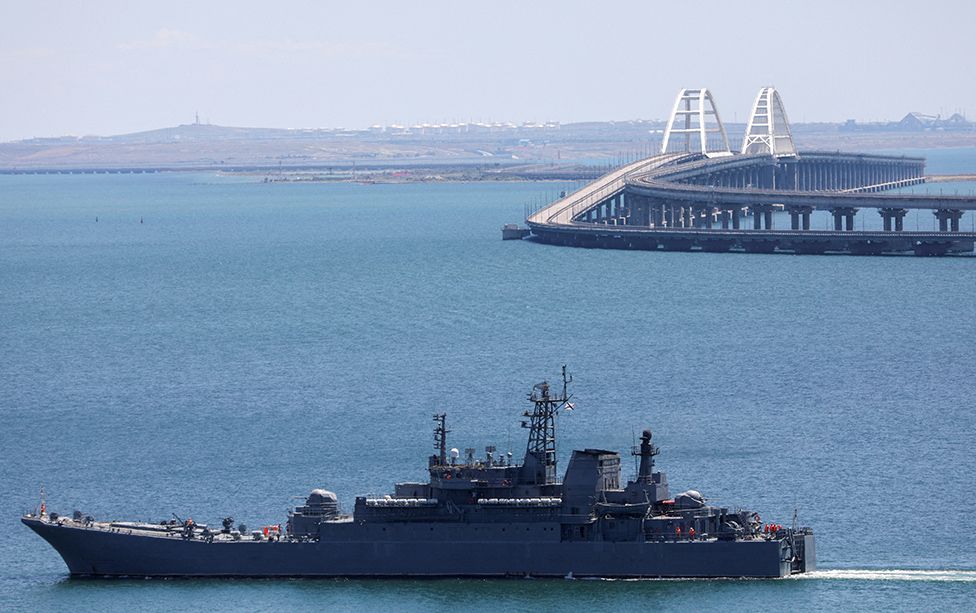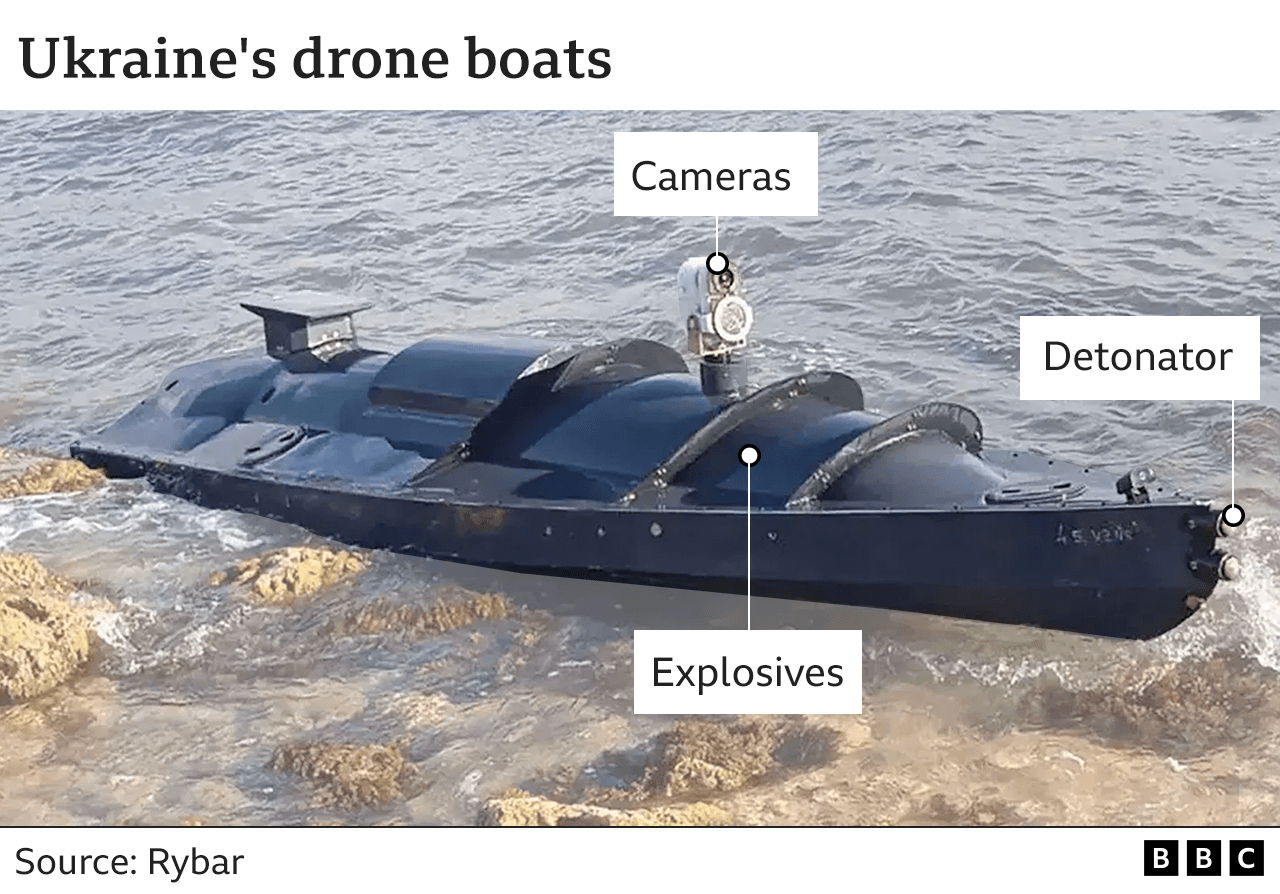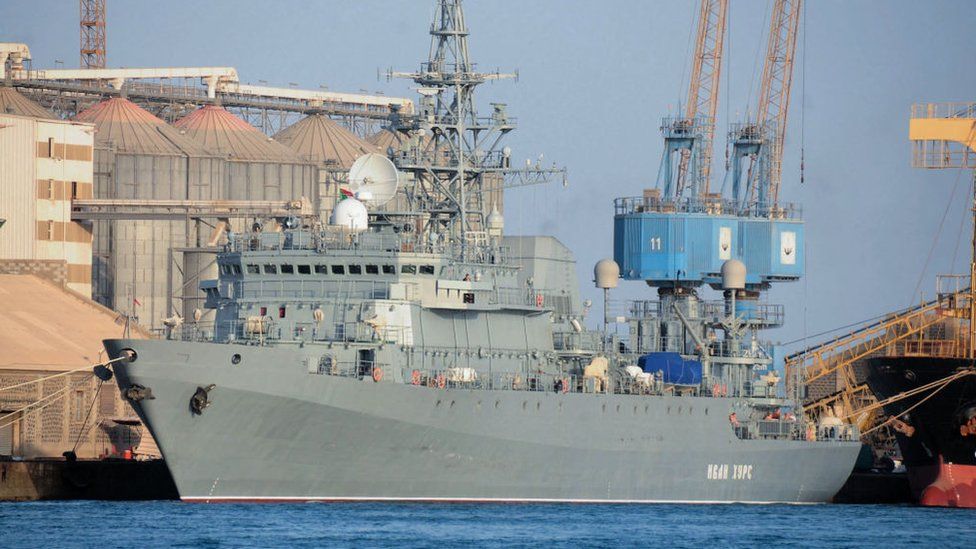Sea drones: What are they and how much do they cost?

A Russian tanker has been hit in a Ukrainian attack in the Black Sea, according to Russian officials. A Ukrainian security source has told the BBC that the strike was carried out by a sea drone.
On 4 August, Russia said it had repelled an attack by this type of drone on one of its naval bases in the region.
While aerial drones have been used to great effect during the conflict, this new form of seaborne technology has been gaining momentum – and it may change the future of naval warfare.
What are sea drones?
Sea drones are small, unmanned vessels. Unlike aerial drones, these ones operate on or below the water’s surface.
There are many terms used to describe them, including drone boats, drone ships and uncrewed surface vessels (USVs).
They come in all shapes and sizes and are used for a variety of tasks, including environmental monitoring.
These drones can be used for military purposes too – like clearing mines, carrying out surveillance or detonating near targets like enemy ships.
Several sea drones have been pictured since the start of the war, including one which reportedly washed up on the shores of Russian-occupied Crimea.

As well as drones that operate on the water’s surface, Ukraine recently unveiled a prototype of an unmanned, undersea drone called the Toloka TLK-150.
How do sea drones work and how much do they cost?
Common sea drone features include built-in explosives and cameras which beam back images to the person controlling it.
Long-range targets are typically pre-programmed into the drones when launched.
They are then guided remotely by a human as they close in on the target, explains Sidharth Kaushal from the defence think tank Rusi.
Some Ukrainian sea drones have been developed with help from crowdfunding campaigns. They are usually made with “off-the-shelf” components normally for commercial – rather than military – use, adds Mr Kaushal.
Russian media and bloggers have claimed that Russia also used them in an attack on a bridge in the port city of Odesa. However, the BBC has seen no evidence to support this.
How many sea drones each side holds is not publicly known. It’s also unclear how much they cost, but one drone publicised by the Ukrainian government has a price tag of $250,000 (£197,000). That would be cheaper than many types of long-range missile.
Sea drones can also be deployed quickly and without the need for a fully-trained crew.
“Even if you intercept a lot of low-cost objects, all you need is one to get through and damage a much more expensive asset and the model has paid for itself,” says Mr Kaushal.
When have sea drones been used against Russia?
BBC Verify’s research suggests Ukraine has carried out at least 12 attacks with sea drones – targeting military ships, Russia’s naval base in Sevastopol, and Novorossiysk harbour. This is based on announcements by Russian and Ukrainian authorities, and local media reports.
Ukrainian defence sources have told CNN that sea drones were also used in an attack on the Kerch Bridge in July.
Some attacks have been far from Ukrainian shores.
In May, footage emerged showing drone ships approaching a Russian intelligence-gathering ship called the Ivan Khurs, but it’s unclear if the ship was damaged.

Russia says the incident took place 90 miles (140km) north of Turkey’s Bosphorus Strait – around 120 miles (193km) from the Ukrainian coast. This suggests these drones can potentially travel long distances.
What impact are sea drones having on the war?
Ukraine’s deployment of sea drones, at relatively low cost, marks a new era for naval warfare. The tactic poses an increasing risk to Russia, according to some analysts.
Compared with naval vessels, sea drones are harder to detect on radar because they travel low on the water and they make far less noise.
While Ukraine does not have a substantial navy, its sea drones have stopped Russia from taking full control of the Black Sea, says Katarzyna Zysk, a professor at the Norwegian Institute of Defence Studies.
The attack on Russia’s naval base in Sevastopol, back in October 2022, was the first in recorded history to use both sea and aerial drones.
At least three Russian ships were damaged in the attack, according GeoConfirmed, an organisation that analyses satellite and other open source imagery. Since then, Russia has significantly bolstered defences around the base according to recent satellite images seen by BBC Verify.
Sea drones still have some disadvantages.
On-board sensors may have a narrow field of view, which will make it hard to track moving targets without accurate location data or to spot camouflaged ships.
Those with onboard cameras also need constant communication with their controller to direct them to a target, so any issues with streaming video will jeopardise their mission.
“It’s not a revolution as yet,” says Prof Zysk. “We’re still in an experimental phase”.
Nonetheless, Ukraine’s strategy has caught international attention, and is “pushing other navies to develop these kind of systems and their operational practice,” she adds.


